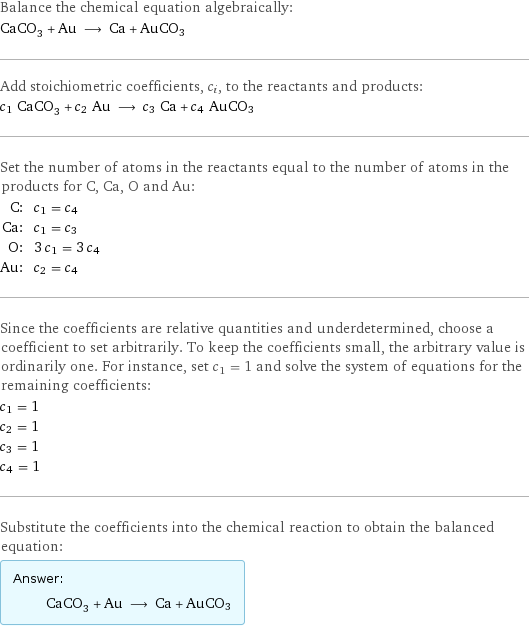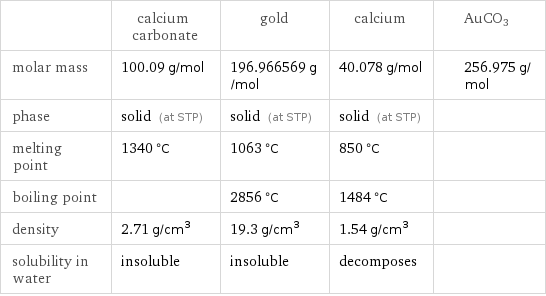Input interpretation

CaCO_3 calcium carbonate + Au gold ⟶ Ca calcium + AuCO3
Balanced equation

Balance the chemical equation algebraically: CaCO_3 + Au ⟶ Ca + AuCO3 Add stoichiometric coefficients, c_i, to the reactants and products: c_1 CaCO_3 + c_2 Au ⟶ c_3 Ca + c_4 AuCO3 Set the number of atoms in the reactants equal to the number of atoms in the products for C, Ca, O and Au: C: | c_1 = c_4 Ca: | c_1 = c_3 O: | 3 c_1 = 3 c_4 Au: | c_2 = c_4 Since the coefficients are relative quantities and underdetermined, choose a coefficient to set arbitrarily. To keep the coefficients small, the arbitrary value is ordinarily one. For instance, set c_1 = 1 and solve the system of equations for the remaining coefficients: c_1 = 1 c_2 = 1 c_3 = 1 c_4 = 1 Substitute the coefficients into the chemical reaction to obtain the balanced equation: Answer: | | CaCO_3 + Au ⟶ Ca + AuCO3
Structures

+ ⟶ + AuCO3
Names

calcium carbonate + gold ⟶ calcium + AuCO3
Equilibrium constant
![Construct the equilibrium constant, K, expression for: CaCO_3 + Au ⟶ Ca + AuCO3 Plan: • Balance the chemical equation. • Determine the stoichiometric numbers. • Assemble the activity expression for each chemical species. • Use the activity expressions to build the equilibrium constant expression. Write the balanced chemical equation: CaCO_3 + Au ⟶ Ca + AuCO3 Assign stoichiometric numbers, ν_i, using the stoichiometric coefficients, c_i, from the balanced chemical equation in the following manner: ν_i = -c_i for reactants and ν_i = c_i for products: chemical species | c_i | ν_i CaCO_3 | 1 | -1 Au | 1 | -1 Ca | 1 | 1 AuCO3 | 1 | 1 Assemble the activity expressions accounting for the state of matter and ν_i: chemical species | c_i | ν_i | activity expression CaCO_3 | 1 | -1 | ([CaCO3])^(-1) Au | 1 | -1 | ([Au])^(-1) Ca | 1 | 1 | [Ca] AuCO3 | 1 | 1 | [AuCO3] The equilibrium constant symbol in the concentration basis is: K_c Mulitply the activity expressions to arrive at the K_c expression: Answer: | | K_c = ([CaCO3])^(-1) ([Au])^(-1) [Ca] [AuCO3] = ([Ca] [AuCO3])/([CaCO3] [Au])](../image_source/ac3559c797598761d58d1cdb10578eda.png)
Construct the equilibrium constant, K, expression for: CaCO_3 + Au ⟶ Ca + AuCO3 Plan: • Balance the chemical equation. • Determine the stoichiometric numbers. • Assemble the activity expression for each chemical species. • Use the activity expressions to build the equilibrium constant expression. Write the balanced chemical equation: CaCO_3 + Au ⟶ Ca + AuCO3 Assign stoichiometric numbers, ν_i, using the stoichiometric coefficients, c_i, from the balanced chemical equation in the following manner: ν_i = -c_i for reactants and ν_i = c_i for products: chemical species | c_i | ν_i CaCO_3 | 1 | -1 Au | 1 | -1 Ca | 1 | 1 AuCO3 | 1 | 1 Assemble the activity expressions accounting for the state of matter and ν_i: chemical species | c_i | ν_i | activity expression CaCO_3 | 1 | -1 | ([CaCO3])^(-1) Au | 1 | -1 | ([Au])^(-1) Ca | 1 | 1 | [Ca] AuCO3 | 1 | 1 | [AuCO3] The equilibrium constant symbol in the concentration basis is: K_c Mulitply the activity expressions to arrive at the K_c expression: Answer: | | K_c = ([CaCO3])^(-1) ([Au])^(-1) [Ca] [AuCO3] = ([Ca] [AuCO3])/([CaCO3] [Au])
Rate of reaction
![Construct the rate of reaction expression for: CaCO_3 + Au ⟶ Ca + AuCO3 Plan: • Balance the chemical equation. • Determine the stoichiometric numbers. • Assemble the rate term for each chemical species. • Write the rate of reaction expression. Write the balanced chemical equation: CaCO_3 + Au ⟶ Ca + AuCO3 Assign stoichiometric numbers, ν_i, using the stoichiometric coefficients, c_i, from the balanced chemical equation in the following manner: ν_i = -c_i for reactants and ν_i = c_i for products: chemical species | c_i | ν_i CaCO_3 | 1 | -1 Au | 1 | -1 Ca | 1 | 1 AuCO3 | 1 | 1 The rate term for each chemical species, B_i, is 1/ν_i(Δ[B_i])/(Δt) where [B_i] is the amount concentration and t is time: chemical species | c_i | ν_i | rate term CaCO_3 | 1 | -1 | -(Δ[CaCO3])/(Δt) Au | 1 | -1 | -(Δ[Au])/(Δt) Ca | 1 | 1 | (Δ[Ca])/(Δt) AuCO3 | 1 | 1 | (Δ[AuCO3])/(Δt) (for infinitesimal rate of change, replace Δ with d) Set the rate terms equal to each other to arrive at the rate expression: Answer: | | rate = -(Δ[CaCO3])/(Δt) = -(Δ[Au])/(Δt) = (Δ[Ca])/(Δt) = (Δ[AuCO3])/(Δt) (assuming constant volume and no accumulation of intermediates or side products)](../image_source/46b303dfae611d0587883c3ce0fcaee4.png)
Construct the rate of reaction expression for: CaCO_3 + Au ⟶ Ca + AuCO3 Plan: • Balance the chemical equation. • Determine the stoichiometric numbers. • Assemble the rate term for each chemical species. • Write the rate of reaction expression. Write the balanced chemical equation: CaCO_3 + Au ⟶ Ca + AuCO3 Assign stoichiometric numbers, ν_i, using the stoichiometric coefficients, c_i, from the balanced chemical equation in the following manner: ν_i = -c_i for reactants and ν_i = c_i for products: chemical species | c_i | ν_i CaCO_3 | 1 | -1 Au | 1 | -1 Ca | 1 | 1 AuCO3 | 1 | 1 The rate term for each chemical species, B_i, is 1/ν_i(Δ[B_i])/(Δt) where [B_i] is the amount concentration and t is time: chemical species | c_i | ν_i | rate term CaCO_3 | 1 | -1 | -(Δ[CaCO3])/(Δt) Au | 1 | -1 | -(Δ[Au])/(Δt) Ca | 1 | 1 | (Δ[Ca])/(Δt) AuCO3 | 1 | 1 | (Δ[AuCO3])/(Δt) (for infinitesimal rate of change, replace Δ with d) Set the rate terms equal to each other to arrive at the rate expression: Answer: | | rate = -(Δ[CaCO3])/(Δt) = -(Δ[Au])/(Δt) = (Δ[Ca])/(Δt) = (Δ[AuCO3])/(Δt) (assuming constant volume and no accumulation of intermediates or side products)
Chemical names and formulas

| calcium carbonate | gold | calcium | AuCO3 formula | CaCO_3 | Au | Ca | AuCO3 Hill formula | CCaO_3 | Au | Ca | CAuO3 name | calcium carbonate | gold | calcium |
Substance properties

| calcium carbonate | gold | calcium | AuCO3 molar mass | 100.09 g/mol | 196.966569 g/mol | 40.078 g/mol | 256.975 g/mol phase | solid (at STP) | solid (at STP) | solid (at STP) | melting point | 1340 °C | 1063 °C | 850 °C | boiling point | | 2856 °C | 1484 °C | density | 2.71 g/cm^3 | 19.3 g/cm^3 | 1.54 g/cm^3 | solubility in water | insoluble | insoluble | decomposes |
Units
